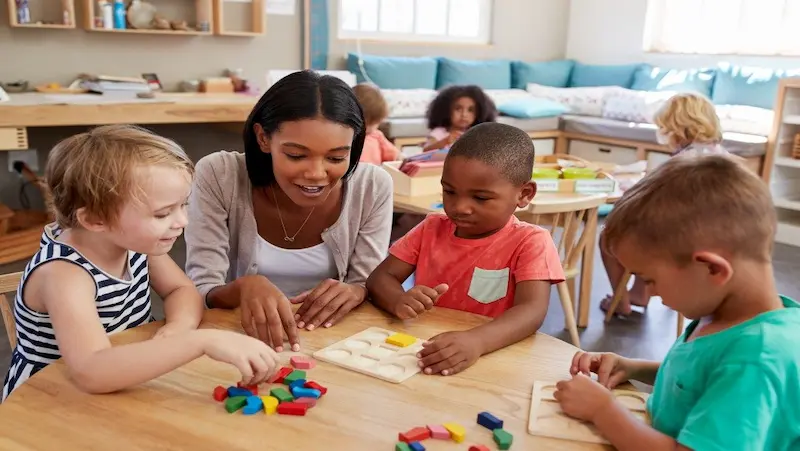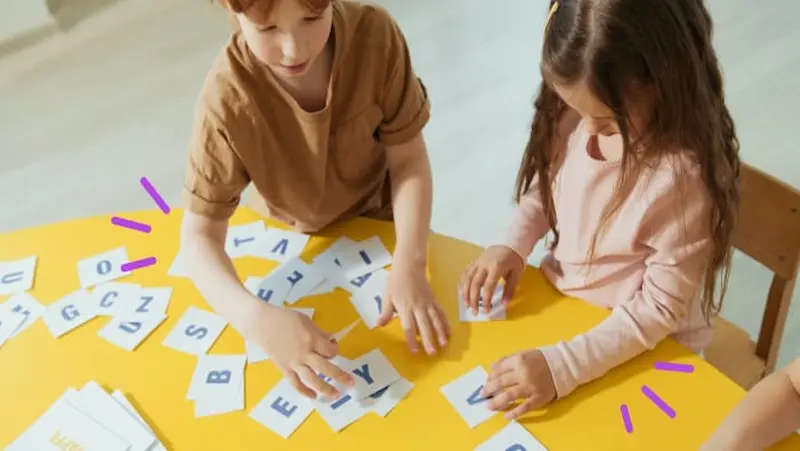In a world increasingly dominated by screens and digital media, it is essential to harness technology’s potential for educational purposes. However, it is important to strike a balance and ensure that educational games are used as complementary tools, supplementing and enhancing traditional teaching methods rather than replacing them.
When utilized effectively and thoughtfully, educational games can become a catalyst for academic success and a lifelong passion for learning. In this article, we will delve deeper into the world of educational games for children, exploring their benefits, potential challenges, and best practices for incorporating them into the educational landscape.
Additionally, consider exploring coding for kids with our exciting coding classes for kids, where they can learn Python for kids in a fun and engaging manner!”
So join us as we embark on a captivating journey through the realm of educational games, where entertainment and enlightenment intertwine to shape the young minds of tomorrow.
Table of contents
Why Learning Games Matter for Kids
In today’s digital era, learning games have become increasingly popular among parents, educators, and children alike. With advancements in technology, these interactive games offer a unique blend of entertainment and education, making them a powerful tool for supporting child development.
In this blog, we will explore the educational value of learning games and delve into their vital role in fostering children’s growth.

Engaging and Motivating Learning Experiences
Traditional teaching methods often struggle to capture and maintain children’s attention and motivation. Learning games, on the other hand, are designed to be highly engaging and captivating.
By integrating educational content into a game format, these interactive experiences entice children to participate actively in the learning process. Whether it’s solving puzzles, completing quests, or exploring virtual worlds, learning games create an enjoyable and motivating environment that enhances children’s willingness to learn.
Enhanced Problem-Solving and Critical Thinking Skills
Learning games are renowned for their ability to promote problem-solving and critical thinking skills in children. Many of these games for kids present challenges and obstacles that require players to think creatively and strategically to overcome them.
Through trial and error, children learn to analyze situations, develop logical reasoning, and devise effective solutions. These problem-solving experiences not only enhance their cognitive abilities but also instill a sense of persistence and resilience.
Personalized Learning and Adaptability
Every child learns at their own pace and has unique strengths and weaknesses. Learning games offer the advantage of adaptability, allowing children to progress through the material at a pace that suits their individual needs.
These games often employ adaptive algorithms that adjust the difficulty level based on the child’s performance, ensuring a personalized learning experience. By catering to individual abilities, learning games provide children with the opportunity to grasp concepts effectively and build a solid foundation of knowledge.
Reinforcing Academic Concepts
Learning games cover a wide range of subjects, including mathematics, language arts, science, history, and more. By incorporating academic content into an interactive and engaging format, these games reinforce classroom lessons and concepts.
Whether it’s practicing multiplication tables, improving vocabulary, or exploring scientific principles, children can consolidate their understanding through repeated exposure in a fun and interactive manner. Learning games act as supplementary tools that complement traditional educational methods and make learning more enjoyable.
Collaboration and Social Skills
Many learning games now offer multiplayer or cooperative features, fostering collaboration and social interaction among children. These games encourage teamwork, communication, and problem-solving in a shared virtual environment.
Children can collaborate with their peers, discuss strategies, and work together towards common goals. By promoting social skills and cooperation, learning games prepare children for real-life social interactions and equip them with essential skills for future success.
Cultivating Digital Literacy and Technological Competence
In an increasingly digital world, it is crucial for children to develop digital literacy and technological competence. Learning games provide a safe and controlled environment for children to explore technology, learn how to navigate digital interfaces, and understand the responsible use of digital tools.
By engaging with educational games, children develop familiarity and comfort with technology, which is essential for their future academic and professional endeavors.
Age-Appropriate Learning Games
These games not only entertain but also facilitate cognitive, social, and emotional development. In this blog, we will explore some of the best learning online games for kids available for different age groups, including toddlers, preschoolers, and elementary school children.

Learning Games for Toddlers (Ages 1-3):
During the toddler years, children are rapidly absorbing information and developing crucial skills. The following learning games are designed to enhance their cognitive and motor abilities while fostering a love for learning:
Shape Sorters and Puzzles:
Toddlers can enjoy shape sorters and puzzles that encourage problem-solving, fine motor skills, and shape recognition. These games promote hand-eye coordination and spatial awareness.
Sensory Apps and Games:
Sensory apps provide stimulating visuals, sounds, and interactive elements that engage toddlers’ senses. These games introduce them to colors, shapes, and basic concepts like numbers and letters.
Picture Books with Interactive Features:
Interactive picture books for kids on tablets or smartphones allow toddlers to explore stories, characters, and sounds with simple tap-and-play interactions. Such games promote early literacy skills and language development.
Learning Games for Preschoolers (Ages 3-5):
Preschool is a crucial period for preparing children for academic and social challenges. Here are some learning games that cater to their growing abilities:
Letter and Number Recognition:
Preschoolers can benefit from games that focus on letter and number recognition. These games often incorporate playful animations, songs, and quizzes to make learning enjoyable and engaging.
Creative Building and Problem-Solving Games:
Building blocks for kids games and puzzles help preschoolers develop problem-solving skills, spatial reasoning, and hand-eye coordination. Such games encourage creativity, logical thinking, and perseverance.
Memory and Matching Games:
Memory games that involve matching pairs of cards or pictures are ideal for preschoolers. These games enhance their memory skills, concentration, and visual discrimination while offering a fun challenge.
Learning Games for Elementary School Children (Ages 6-12):
As children progress to elementary school, their learning needs expand. Here are some learning games that align with their cognitive development and academic growth:
Math and Science Games:
Interactive math and science games enable elementary school children to explore concepts, practice skills, and develop a deeper understanding. These games often incorporate problem-solving tasks, quizzes, and experiments.
Language and Vocabulary Games:
Elementary school children can enhance their language skills through games that focus on spelling, grammar, and vocabulary. Word puzzles, crosswords, and word-building games promote literacy and linguistic development.
Strategy and Critical Thinking Games:
Strategy games, such as chess or logic puzzles, challenge children’s critical thinking abilities, planning skills, and decision-making. These games foster logical reasoning, strategic thinking, and perseverance.
Top Learning Games for Kids
As technology continues to evolve, incorporating it into children’s education has become increasingly common. Learning games offer an exciting way to engage kids while enhancing their cognitive abilities, problem-solving skills, and knowledge retention.
In this blog, we will explore some of the most popular and effective learning games for kids, designed to make learning enjoyable and interactive.

“ABCmouse”:
ABCmouse is an immersive online learning platform that caters to children aged 2 to 8. It offers a comprehensive curriculum covering various subjects, including reading, math, science, and art. The game utilizes interactive activities for kids, animations, and rewards to keep children motivated and engaged. ABCmouse adapts to each child’s individual progress and offers a structured learning path, making it an excellent tool for early education.
“Minecraft Education Edition”:
Minecraft, a beloved sandbox game, has a specialized version called “Minecraft Education Edition” that promotes creativity and critical thinking. This fun and educational activities for kids adaptation allows kids to explore historical sites, solve math problems, learn coding basics, and even experiment with renewable energy concepts. By blending virtual construction and exploration with educational content, Minecraft Education Edition fosters problem-solving skills and collaborative learning.
“Khan Academy Kids”:
Khan Academy Kids is a free learning app suitable for children aged 2 to 7. It covers various subjects, including literacy, math, social-emotional development, and creative expression. The app offers a wide range of interactive activities, stories for kids, and games designed to enhance early learning. Khan Academy Kids also features engaging characters and adaptive learning paths, making it a valuable resource for parents and educators.
“Scratch”:
Scratch is a beginner-friendly coding platform created by MIT Media Lab. It enables kids aged 8 and above to create their own interactive short stories for kids, games, and animations. By learning to code in a visual and intuitive manner, children develop problem-solving skills, computational thinking, and creativity. Scratch fosters a sense of accomplishment as kids can share and showcase their creations with a supportive online community.
“Math Blaster”:
Math Blaster is a popular math-based game that transforms learning arithmetic into an exciting space adventure. Aimed at children aged 6 to 12, the game provides a combination of skill-building exercises and thrilling missions. Math Blaster offers a wide range of math concepts, from basic operations to fractions and algebra. By completing challenges and solving math problems, children can improve their numeracy skills while having a blast.
“Duolingo”:
Duolingo is a widely-used language-learning app suitable for both kids and adults. With its gamified approach, Duolingo makes learning a new language enjoyable and interactive. Kids can learn languages such as Spanish, French, German, and more through fun exercises, quizzes, and challenges. The app tracks progress, encourages regular practice, and provides a sense of accomplishment as kids advance through various levels.
How to Choose the Right Learning Games
In today’s technology-driven world, learning games have become an integral part of education. They offer an interactive and engaging way for children to acquire knowledge and develop essential skills.
However, with countless options available, choosing the right learning games for kids can be a daunting task. To ensure that your child benefits from these educational tools, it is important to consider various factors such as age appropriateness, subject matter, and learning objectives.
This blog post will provide you with a comprehensive guide to help you make informed decisions when selecting learning games for your child.

Determine the Age Appropriateness:
When selecting learning games, the first consideration should be the age of your child. Different games are designed to target specific age groups, taking into account their cognitive abilities and developmental stage.
Look for games that are labeled or categorized by age range to ensure they align with your child’s capabilities. Younger children may benefit from games that focus on basic concepts such as colors, shapes, and numbers, while older children might require more complex games that involve problem-solving and critical thinking skills.
Consider the Subject Matter:
Learning games cover a wide range of subjects, including math, science, language arts, history, and more. Consider your child’s interests and educational needs when choosing a game. If your child is struggling with a particular subject, look for games that specifically target that area to provide additional practice and reinforcement.
On the other hand, if your child is enthusiastic about a certain topic, finding games that align with their interests can enhance their motivation to learn.
Evaluate Learning Objectives:
Clearly define the learning objectives you want to achieve through the learning game. Is it to improve problem-solving skills, enhance creativity, or develop critical thinking abilities? Take the time to understand the goals and objectives of the game you are considering.
Look for games that have well-defined learning outcomes and align with your child’s educational needs. Reading reviews or seeking recommendations from educators or other parents can provide valuable insights into a game’s effectiveness in achieving specific learning goals.
Assess Engagement and Interactivity:
One of the main advantages of learning games is their ability to engage children actively. Look for games that offer interactive elements, such as puzzles, quizzes, or challenges, as they promote active participation and foster a deeper understanding of the content.
Games with captivating graphics, engaging storylines, and appealing characters can also enhance motivation and enjoyment, making the learning experience more effective.
Check for Educational Value:
Learning games should provide a balance between entertainment and educational value. While it is important for children to have fun while playing, the game should also deliver meaningful educational content. Check if the game aligns with established educational standards or curriculum guidelines.
Look for games that encourage critical thinking, problem-solving, decision-making, and other important skills. Additionally, games that adapt to the child’s progress and provide personalized learning experiences can be particularly beneficial.
Consider Parental Controls and Safety:
Ensure that the learning game provides appropriate parental controls and safety measures. Check if the game has features that allow parents to monitor their child’s progress, set time limits, or restrict access to certain content. Additionally, consider the game’s online features, if any, and evaluate the safety measures in place to protect your child from potential risks.
Incorporating Learning Games into Daily Routine
In the age of technology and digital advancements, learning games have emerged as powerful tools to engage and educate children in a fun and interactive manner. Incorporating these games into a child’s daily routine can not only enhance their academic skills but also foster their curiosity, critical thinking abilities, and problem-solving skills.

In this blog, we will explore practical strategies to seamlessly integrate learning games into a child’s daily routine, ensuring a balanced approach to education and play.
Understand the Benefits:
Before diving into incorporating learning games, it is crucial to understand the benefits they offer. Learning games provide an engaging learning environment that encourages active participation and boosts motivation.
They can enhance various skills such as problem-solving, decision-making, creativity, and collaboration. Recognizing these benefits will help you appreciate the value of integrating learning games into your child’s routine.
Identify Educational Goals:
Begin by identifying the educational goals you want your child to achieve. This could include improving math skills, language proficiency, logical reasoning, or enhancing general knowledge. By having specific goals in mind, you can select learning games that align with those objectives, ensuring that the games are both enjoyable and educational.
Research and Choose Suitable Learning Games:
The next step is to research and select appropriate learning games based on your child’s age, interests, and educational goals. There is a vast array of educational apps, online platforms, and interactive toys available. Read reviews, seek recommendations, and consider the quality, age-appropriateness, and learning outcomes of each game before introducing it to your child.
Integrate Games into Daily Schedule:
To seamlessly incorporate learning games, integrate them into your child’s daily schedule. Identify pockets of time where they can engage in these games without disrupting their routine or other essential activities.
It could be during free time, after completing homework, or as a break from traditional study methods. By making learning games a part of their routine, they become a natural and enjoyable component of their day.
Establish Rules and Limits:
To maintain a healthy balance between learning games and other activities, establish clear rules and limits. Set specific time slots for playing learning games and communicate the expectations to your child.
By doing so, you ensure that they do not become overly dependent on screens and maintain a well-rounded routine that includes physical activities, social interactions, and other offline learning experiences.
Participate and Engage:
Make learning games a shared experience by participating and engaging with your child. Play together, ask questions, and discuss the concepts or challenges within the game. This involvement not only strengthens the parent-child bond but also provides an opportunity to reinforce the educational content and extend the learning beyond the game itself.
Leverage Real-World Connections:
Learning games can be more effective when they are connected to real-world experiences. Encourage your child to apply the skills and knowledge gained from the games to practical situations.
For example, if they are playing a geography game, you can plan a family outing to explore local landmarks or cuisines. By bridging the gap between virtual and real-world contexts, children develop a deeper understanding and appreciation for what they learn.
Monitor Progress and Adapt:
Regularly monitor your child’s progress and adapt the learning games accordingly. Observe their engagement, comprehension, and skill development. If you notice a particular game is not effective or has become repetitive, explore new options that cater to their evolving needs and interests. Flexibility and adaptability ensure that learning games remain stimulating and beneficial for your child.
Conclusion
In conclusion, I strongly encourage parents to explore the suggested learning games and begin incorporating them into their children’s education. The world is constantly evolving, and it is essential for our children to acquire the necessary skills to thrive in the 21st century.
By integrating educational games into their learning routine, parents can provide their children with an engaging and interactive way to develop various cognitive and social abilities.
These learning games offer a multitude of benefits. They promote critical thinking, problem-solving, creativity, and collaboration skills, which are all vital for success in today’s rapidly changing world. Moreover, these games often present complex concepts in a simplified and enjoyable manner, making it easier for children to grasp and retain information.
By incorporating learning games into their children’s education, parents can create a positive and supportive learning environment at home. These games can be used as a supplement to traditional classroom learning or as standalone educational tools. They provide an opportunity for parents to actively participate in their children’s education and foster a love for learning.
Incorporating learning games into children’s education not only enhances their academic performance but also nurtures essential life skills. These games encourage curiosity, adaptability, perseverance, and self-confidence, which are qualities that will benefit children throughout their lives.
In conclusion, by embracing the use of learning games, parents can make education more enjoyable, interactive, and effective for their children. I urge all parents to explore the suggested learning games and take an active role in their children’s learning journey. Together, we can empower the next generation to become lifelong learners and thrive in an ever-changing world.
Unlock the Gateway to a Brighter Future with BrightChamps: Our comprehensive edutech platform offers a unique fusion of robotics, financial education, and coding courses, tailored for curious young minds.
Frequently Asked Questions
A1. Learning games for kids are interactive activities designed to educate and engage children while they play. These games incorporate educational content and concepts into a fun and enjoyable format.
A2. Learning games can benefit your child’s development by promoting cognitive skills, problem-solving abilities, creativity, critical thinking, and academic knowledge. They also enhance social skills, hand-eye coordination, and digital literacy.
A3. Yes, learning games are designed to cater to various age groups, from toddlers to teenagers. They are often categorized based on age appropriateness, allowing children to engage with content suitable for their developmental stage.
A4. To choose the right learning games for your child, consider their interests, educational goals, and age. Look for games that align with their skill level, offer engaging and age-appropriate content, and have positive reviews or recommendations from trusted sources.
A5. Yes, there are many free learning games available online and through mobile applications. Numerous websites and platforms offer a wide range of educational games at no cost, providing accessible learning resources for children.
A6. Learning games can complement traditional teaching methods, but they are not intended to replace them entirely. They serve as supplementary tools to reinforce learning and make it more interactive and engaging for children.
A7. Most learning games designed for kids prioritize safety by providing age-appropriate content and incorporating appropriate privacy measures. However, it is essential to review and supervise the games your child accesses to ensure they are suitable and safe.
A8. The appropriate amount of screen time for kids varies based on their age and individual circumstances. It is generally recommended to balance screen time with other activities and set limits that promote a healthy lifestyle. Consult guidelines from reputable sources, such as pediatricians or educational experts, to determine suitable screen time limits for your child.










